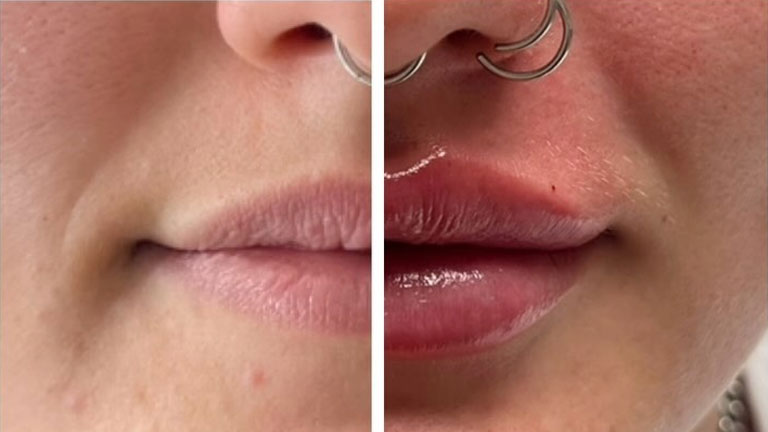
Lip fillers have surged in popularity as a cosmetic procedure, offering a way to enhance one’s appearance with fuller, more defined lips. This guide aims to explain the process and provide essential insights for those considering lip fillers. It is crucial to be well-informed about every aspect of the procedure – from selecting the right type of filler to understanding the potential risks involved. This guide serves as a comprehensive source to answer your questions and guide you through making a well-informed decision.
1. Understanding Lip Fillers
Lip fillers are injectable substances used to enhance the volume and shape of the lips. Typically, these fillers consist of hyaluronic acid, a substance naturally found in the body, known for its capacity to retain moisture and create a plump appearance. Other types include collagen and fat injections, each offering distinct benefits and results. The primary goal of lip fillers is not just to increase size but also to improve symmetry and contour, giving a more youthful and appealing look. This cosmetic treatment has gained immense popularity due to its relatively quick procedure time and noticeable immediate results.
2. The Procedure: What to Expect
The lip filler procedure typically begins with a consultation, where you discuss your goals and any concerns with your practitioner. During the actual procedure, a numbing cream may be applied to minimize discomfort. The filler is then injected into specific areas of the lips to achieve the desired shape and volume. The process usually takes less than an hour, and the results are immediate. After the procedure, it is common to experience mild swelling or bruising, which typically subsides within a matter of days. Following your practitioner’s aftercare instructions is crucial for the best results and minimizing potential complications.
3. Potential Risks and Side Effects
While lip fillers are generally safe when performed by a qualified professional, they do carry potential risks and side effects. Common side effects include swelling, redness, and bruising in the injected area. More serious complications, though rare, can include allergic reactions, infection, or asymmetry. It is paramount to discuss these risks with your practitioner beforehand and ensure you are receiving treatment in a reputable clinic. Understanding these risks helps in making an informed decision and preparing for any possible outcomes.
4. Cost Considerations
The cost of lip fillers can differ widely depending on different aspects, including the kind of filler used, the practitioner’s experience, and the geographic location of the clinic. Generally, prices range from several hundred to a thousand dollars per session. It is important to note that lip fillers are not a one-time expense; maintenance sessions are required to sustain the results, as fillers gradually dissolve over time. When considering lip fillers, factor in these ongoing costs and ensure that they fit within your budget. Remember, choosing a practitioner based solely on cost can compromise the quality and safety of the procedure, so it is advisable to prioritize expertise and reputation over price.
5. Longevity of Results
The time duration of lip filler effects can vary depending on multiple aspects, including the kind of filler used, the individual’s metabolism, and lifestyle elements such as smoking and sun exposure. Generally, hyaluronic acid fillers last between six to twelve months. Over time, the body naturally absorbs the filler, gradually diminishing the enhanced volume. Regular maintenance sessions are necessary to retain the desired look. It is essential to have realistic expectations about the longevity of the results and to plan for future touch-up treatments to maintain the aesthetic.
6. Pre-Procedure Preparations
Preparing for a lip filler procedure can significantly impact the outcome and recovery. It is advisable to avoid blood thinners, such as aspirin and ibuprofen, as well as supplements like fish oil and vitamin E for a week before the procedure, as they can increase bruising and bleeding. Alcohol should also be avoided at least 24 hours prior. Inform your practitioner about any medications or supplements you are taking to ensure they don’t interfere with the treatment. Hydration is key, so drink plenty of water in the days leading up to your appointment.
7. Choosing the Right Type of Filler
Selecting the right type of filler is crucial for safety and achieving your desired look. Hyaluronic acid-based fillers are the most common and are celebrated for their natural feel and reversible results. However, it is vital to discuss all available options with a certified professional. Factors like allergies desired longevity of results, and the specific look you aim to achieve play a significant role in this decision. Additionally, it is important to consider the reversibility of the procedure. In cases of dissatisfaction or complications, options like silicone injection removal are available, emphasizing the importance of choosing a filler that allows for such corrective measures.
8. Post-Procedure Care
After the procedure, proper care is crucial for optimal results and minimizing complications. Expect some swelling and possibly bruising, which usually subsides within a few days. Applying ice packs can help reduce swelling. It is recommended to avoid tough exercise, heat exposure, and alcohol for at least 2 days post-treatment. Sleeping with your head elevated can also help reduce swelling. Avoiding makeup on the lips for a day is also a good practice. Follow any specific aftercare instructions provided by your practitioner, as these can vary based on the filler used and your treatment.
9. When to See a Doctor
While complications from lip fillers are rare, it is crucial to know when to seek medical attention. If you experience severe pain, asymmetry, skin discoloration, signs of infection (such as fever or excessive swelling), or any unusual symptoms, contact your practitioner immediately. These could be signs of complications such as an allergic reaction or infection. Regular follow-up appointments are important to monitor the results and address any concerns. Your practitioner should provide clear guidelines on when and how to get in touch in case of any issues.
10. Myths vs. Facts
There are many myths surrounding lip fillers, and it is important to separate fact from fiction. One common myth is that lip fillers always look unnatural or overdone; in reality, when done correctly, they can look very natural. Another is the belief that lip fillers are irreversible; most modern fillers are temporary and can even be dissolved if necessary. It is also a misconception that lip fillers are extremely painful; most patients report only mild discomfort. Always rely on information from qualified professionals rather than myths and hearsay.
Conclusion
Lip fillers can be a safe and effective way to enhance your appearance, but it is crucial to approach them with knowledge and caution. Understanding the different types of fillers, the procedure, potential risks, and the importance of professional guidance is key to a positive experience. Remember that maintenance is part of the process, and realistic expectations are essential. Always consult with a qualified practitioner who can provide personalized advice and ensure your safety and satisfaction. By being well-informed, you can make a decision that aligns with your aesthetic goals and overall well-being.




